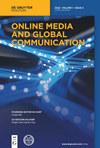Victims or villains? How editorial cartoons depict the 2023 Israel – Palestine war
引用次数: 0
Abstract
The study analyzed online editorial cartoons depicting the Israel-Palestine conflict through visual, symbolic, metaphorical, and textual analysis. The study reveals a prevailing anti-war sentiment across editorial cartoons, with a notable inclination towards supporting Palestine. This support was prominent in cartoons originating from the Global South, particularly Sub-Saharan Africa. However, there was a scarcity of such cartoons within mainstream Western media. The study employs an in-depth approach, analyzing cartoons from both Western and non-Western media. It utilizes Multimodal Discourse Analysis (MDA) and Multimodal Semiotics (MS) theories, focusing on symbolism and text to decode nuanced narratives within the cartoons. The cartoons depict complex narratives, using symbolism to explain how politicians and the main media are framing specific entities while undermining victimology. They reveal subjective perspectives that influence audience perceptions. They echo existing scholarly views on the influential power of editorial cartoons in communicating complex political concepts. The cartoons shape public understanding of the conflict, potentially influencing biases and perspectives. They present Hamas as both an aggressor and a victim, portraying multifaceted perceptions of the group. The findings are instrumental in depicting political identities, including major organizations like the UN. The boldness in depicting such entities provides a practical avenue for understanding the role of such organizations. The study adds to the existing literature by applying multimodal analysis to editorial cartoons, unveiling hidden narratives and perceptions. It suggests the need for a deeper analysis of the conflict’s historical, geopolitical, and power structures. This research offers a multifaceted understanding of how editorial cartoons shape perceptions and interpretations of the Israel-Palestine conflict, emphasizing their complex and influential nature within media discourse.受害者还是恶棍?社论漫画如何描绘 2023 年以巴战争
本研究通过视觉、象征、隐喻和文本分析,对描述以色列-巴勒斯坦冲突的网络社论漫画进行了分析。研究揭示了社论漫画中普遍存在的反战情绪,并明显倾向于支持巴勒斯坦。这种支持在来自全球南部,特别是撒哈拉以南非洲的漫画中尤为突出。然而,在西方主流媒体中,这类漫画却很少见。 本研究采用了一种深入的方法,对西方和非西方媒体的漫画进行了分析。研究采用了多模态话语分析(MDA)和多模态符号学(MS)理论,重点关注象征意义和文本,以解读漫画中的细微叙事。 这些漫画描绘了复杂的叙事,利用象征主义解释了政治家和主要媒体是如何塑造特定的实体,同时削弱受害者论的。它们揭示了影响受众看法的主观视角。这些研究与现有学者关于社论漫画在传播复杂政治概念方面的影响力的观点不谋而合。 这些漫画塑造了公众对冲突的理解,可能会影响偏见和观点。这些漫画将哈马斯展现为侵略者和受害者,描绘了人们对该组织的多方面看法。 这些发现有助于描述政治身份,包括联合国等主要组织。对此类实体的大胆描绘为了解此类组织的作用提供了一条实用途径。 本研究通过对社论漫画进行多模态分析,揭示了隐藏的叙事和观念,为现有文献增添了新的内容。它表明有必要对冲突的历史、地缘政治和权力结构进行更深入的分析。本研究从多方面揭示了社论漫画如何影响人们对以色列-巴勒斯坦冲突的看法和解释,强调了社论漫画在媒体话语中的复杂性和影响力。
本文章由计算机程序翻译,如有差异,请以英文原文为准。
求助全文
约1分钟内获得全文
求助全文
来源期刊

Online Media and Global Communication
Communication, Media Studies, Internet Studies, International Studies, International Relations-
自引率
0.00%
发文量
0
期刊介绍:
Online Media and Global Communication (OMGC) is a new venue for high quality articles on theories and methods about the role of online media in global communication. This journal is sponsored by the Center for Global Public Opinion Research of China and School of Journalism and Communication, Shanghai International Studies University, China. It is published solely online in English. The journal aims to serve as an academic bridge in the research of online media and global communication between the dominating English-speaking world and the non-English speaking world that has remained mostly invisible due to language barriers. Through its structured abstracts for all research articles and uniform keyword system in the United Nations’ official six languages plus Japanese and German (Arabic, Chinese, English, French, Russian, Spanish, Japanese, and German), the journal provides a highly accessible platform to users worldwide. Its unique dual track single-blind and double-blind review system facilitates manuscript reviews with different levels of author identities. OMGC publishes review essays on the state-of-the-art in online media and global communication research in different countries and regions, original research papers on topics related online media and global communication and translated articles from non-English speaking Global South. It strives to be a leading platform for scientific exchange in online media and global communication.
For events and more, consider following us on Twitter at https://twitter.com/OMGCJOURNAL.
Topics
OMGC publishes high quality, innovative and original research on global communication especially in the use of global online media platforms such as Facebook, TikTok, YouTube, Twitter, Instagram, WhatsApp, Weibo, WeChat, Wikipedia, web sites, blogs, etc. This journal will address the contemporary concerns about the effects and operations of global digital media platforms on international relations, international public opinion, fake news and propaganda dissemination, diaspora communication, consumer behavior as well as the balance of voices in the world. Comparative research across countries are particularly welcome. Empirical research is preferred over conceptual papers.
Article Formats
In addition to the standard research article format, the Journal includes the following formats:
● One translation paper selected from Non-English Journals that with high quality as “Gems from the Global South” per issue
● One review essay on current state of research in online media and global communication in a country or region
 求助内容:
求助内容: 应助结果提醒方式:
应助结果提醒方式:


